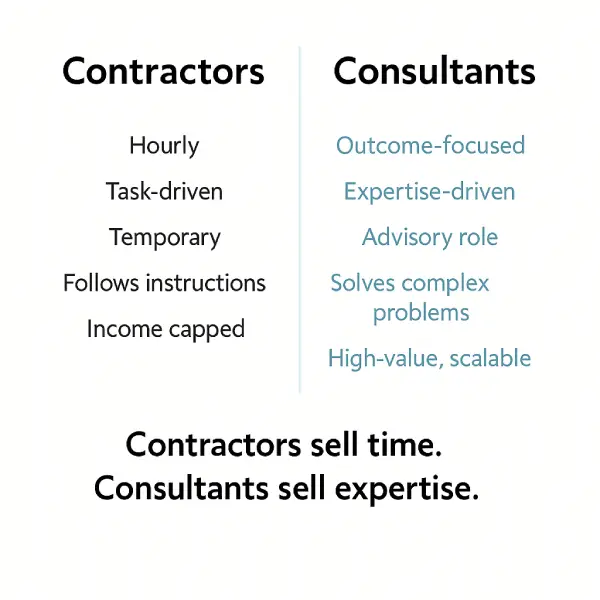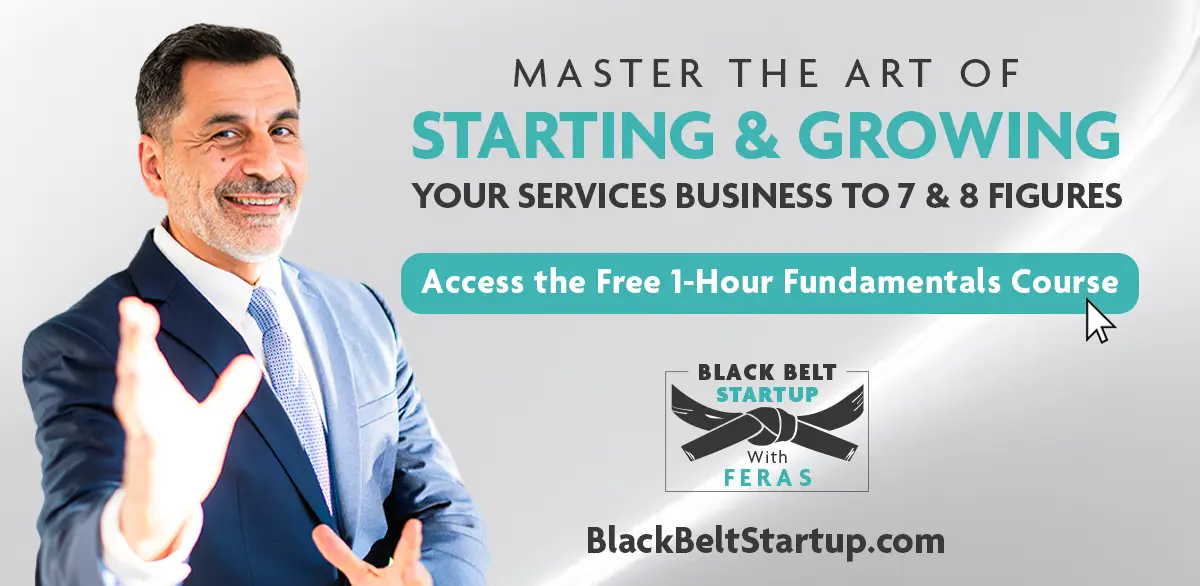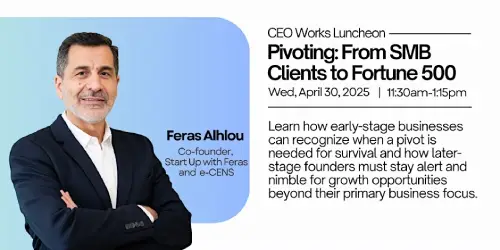Contractor Mindset Keeps You Broke

Good Morning!
Last week I headed down to Santa Cruz to meet with a group of CEOs, seasoned entrepreneurs, and budding entrepreneurs. We talked about how to move from SMBs to bigger clients, including Fortune 500. That’s exactly what we did at e-Nor! We went from selling to local mom and pop shops to Salesforce and the Federal Government. More on this in today’s email!
On the Mat
- Contractor vs. Consultant
- How to Grow Without Betting the Farm
- Create a Winning Project Proposal
- Groove
- 10 Reasons Why 99% of New Business Owners Fail
- Pivoting From SMB Clients to Fortune 500
Let's Train
Contractor vs. Consultant: Is There a Difference?
Years ago, when I first ventured into consulting, I quickly learned there's a critical difference between being a contractor and being a consultant, and it significantly impacts both your growth trajectory, profitability, and your lifestyle.
As a contractor, you're primarily selling your time. Contractors are task-driven, follow specific client instructions, and their value is measured by the hours they dedicate to a project.
This hourly approach, specifically when your hourly rates are low, limits income potential and growth.
Early in my career as a business owner, I found myself trapped here; busy days filled with back-to-back meetings, trying my absolute best to please impossible clients, while simultaneously doing sales.
You’ll live in this cycle forever if you look at your job as meeting client deliverables. Remind me again, wasn’t that what you were doing for your managers as an employee? 🙂
Going independent also has a growth trajectory, and it starts when you shift from selling time to selling expertise.
Consultants sell their expertise, not just their time. Rather than simply executing tasks, consultants provide thoughtful advice, identify the underlying problems, and guide clients toward effective and sustainable solutions.
This approach not only maximizes your value but also allows you to scale your business meaningfully.
For instance, back when I was running a marketing analytics firm, a potential client once offered us $5K to implement a basic tracking code on his e-commerce site—20 hours at $250/hour. Not bad money. But at the time, we were selling full-scope analytics projects for $25K, which included stakeholder discovery, audits, custom implementation, and on-site training. Implementation was only a small part of the actual value we delivered.
This client didn’t want any of that. Just the code. So we passed—respectfully—and referred him to a freelancer who specialized in execution-only work.
We lost the $5K, but secured many more $25K+ clients who valued comprehensive guidance and kept us on long-term retainers. Better results for them, and a business model that was scalable and sustainable for us.

To shift from contractor to consultant, here are practical steps:
- Move beyond low hourly rates: Price your engagements based on the outcomes and value you deliver, not the time spent.
- Ask insightful questions: Focus on uncovering your client’s true business objectives before proposing any solutions.
- Become an advisor: Offer meaningful guidance and expertise, positioning yourself as a trusted partner, not just a service executor.
- Define clear outcomes: Base your engagements around measurable results that clients recognize and value.
- Enable client growth: Equip your clients with lasting capabilities and knowledge, ensuring the benefits of your engagement endure beyond your direct involvement.
By making these adjustments, you'll leverage your expertise more effectively, transforming your business and significantly enhancing your professional satisfaction and financial potential.
It’s ok to envision yourself as a contractor early on, but as you gain more business experience, the natural progression should be to act as a consultant.
Ask Feras Recaps
How to Grow Without Betting the Farm
Daniel, an experienced video production consultant, recently bought a similar business, small, breaking even, with favorable financing terms.
With his existing network and large client accounts, he was ready to upsell and cross-sell additional services like print design, website creation, and digital marketing. Yet something was stopping him from pulling the trigger fully.
🔥 Challenge:
Daniel realized growth requires investment, particularly hiring. But the idea of hiring a salesperson before profits increased was daunting.
He found himself stuck, unsure how to grow without significantly increasing his risk. He hesitated, questioning whether the investment in staffing would pay off or jeopardize his financial stability.
💡 Doing Right:
Daniel had already made smart moves. Buying an existing business allowed him quick entry into the market. He secured solid financing terms and had a clear vision of cross-selling opportunities. Most importantly, Daniel was already positioned with large potential clients, meaning revenue growth was within reach.
🛠️ My Recommendations:
I advised Daniel to start strategically small if cautious about risk. Instead of immediately hiring a full-time salesperson, he could delegate mundane, non-revenue-generating tasks like invoicing and basic accounting to a freelancer or part-timer. Freeing up just a few hours weekly would let him target and secure larger accounts.
📈 The Path Forward
Daniel’s path forward became clear: gradual, intentional delegation. By incrementally offloading administrative burdens, Daniel could safely scale, preserving capital and mitigating risk.
Sustainable growth doesn’t mean reckless spending—it means strategically freeing yourself to chase bigger opportunities.
Details have been changed to protect anonymity and for storytelling purposes.
You Might Like These
I remember writing my first few proposals. It was complete guesswork, hoping something would resonate with the clients.
20 years later, and now I know that great proposals are simple:
- Clearly define the client's challenges
- Present the tailored solution
- Highlight why you're uniquely qualified to deliver the results
When you demonstrate you genuinely understand their needs and position yourself as the obvious choice, trust and a signature follow.
If you haven’t written one before or want to improve how you create yours, this playbook from Pollen is a great overview.
Many of my past businesses were built with people who came of age before smartphones.
But with this latest business, I’m hearing younger team members express their inability to focus and get work done, especially in our remote setup.
If you feel similar, check out Groove, a coworking app that helps business owners and creatives stay focused and feel connected.
And if you want something tailored for new consultants, check out my community blackbelt startup, where I personally have check-ins with you to make sure you’re making progress.
Sharpen Your Blade
1. Fear: Avoiding sales because you're afraid no one will buy guarantees no one will.
2. Wrong problem: Chasing problems not enough people will pay for: tune down your excitement and tune into the market’s needs.
3. Overconfidence: A founder thinks they're too smart to question their own 𝘢𝘴𝘴𝘶𝘮𝘱𝘵𝘪𝘰𝘯𝘴 (spoiler alert: the market will humble them).
4. Perfectionist: Perfect plans don’t get clients—taking action does. Launch before you feel ready.
5. Being picky: Beggars can’t be choosers. Take what comes your way (for now).
6. Getting comfortable: Momentum can be intoxicating. A little success can lead to complacency, leading some to forget that their comfort zone is a cage.
7. Lone wolf syndrome: The solo genius is a myth. You’re a social animal. Work with and get help from people.
8. Ignoring advice: I get it, you are a visionary. But you can avoid making certain mistakes if you listen to more experienced folks.
9. Niching: Too broad or too narrow, and you’ll die. Strike a balance.
10. Complaining: The enterprise of entrepreneurship rests on overcoming challenges. No one cares about how short a hand you were dealt. Show results. That’s all that matters ultimately.
Our first clients were a restaurant and a struggling artist. Eight years, multiple pivots, and plenty of scars later, we were working with Salesforce, the Federal Government, and other big names.
Last week, I shared the journey with a group of business owners. Here were my key lessons:
1. Recognize when to pivot:
Pay attention to industry shifts and client feedback. When your offer becomes commoditized, be willing to evolve to capture higher-value opportunities.
2. Grow through competitors & partnerships:
You don’t need to reinvent the wheel. Learn from adjacent providers and build referral ecosystems. Abundance > scarcity.
3. Kill your darlings:
Success came when we dropped general web dev (we lost money on every project) and doubled down on digital marketing, then specialized in analytics. That’s what attracted enterprise clients.
Pivoting isn’t just a survival tactic. It’s how you scale.
Subscribe to the Black Belt Startup Newsletter
Weekly, 5-minute insights to help you escape the 9–5, land your first clients, and grow a thriving business.




